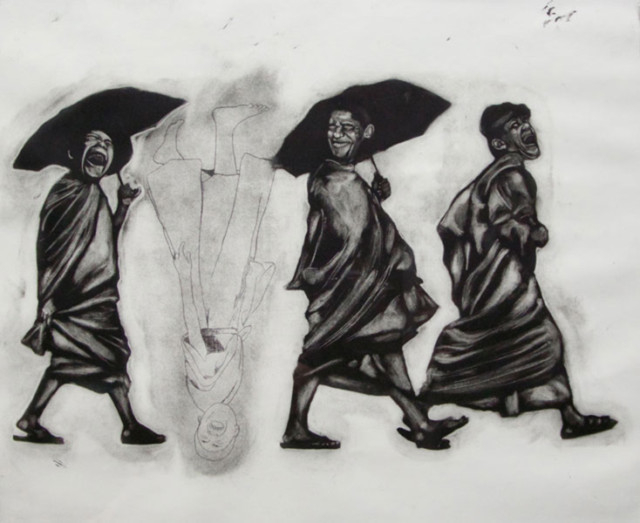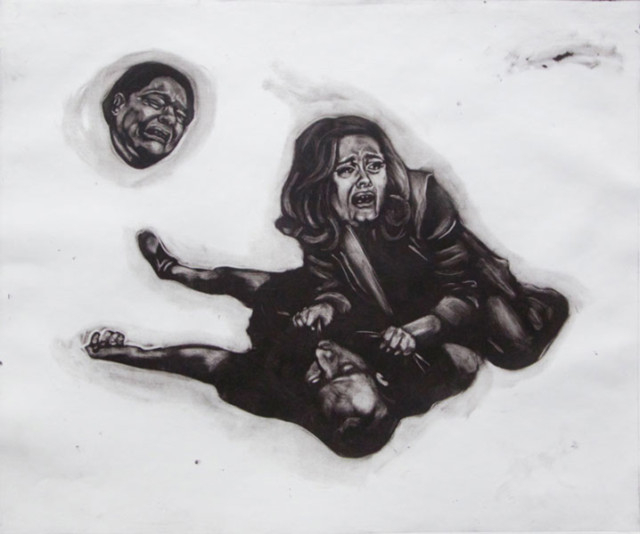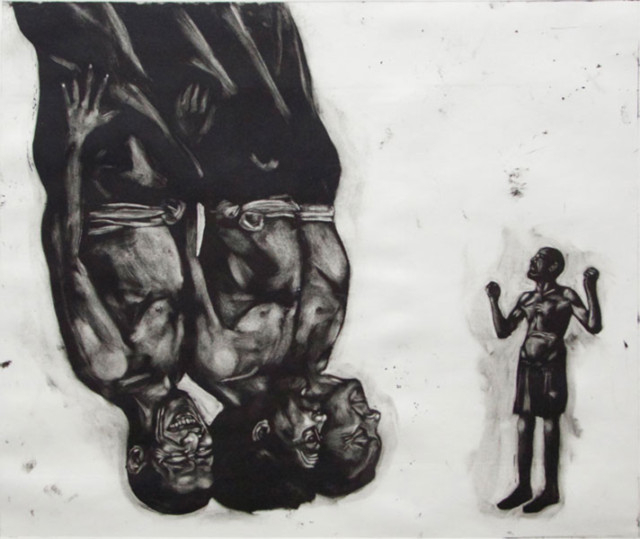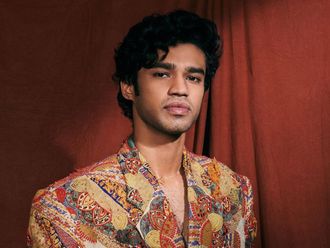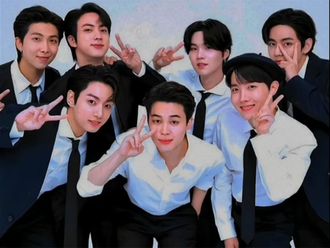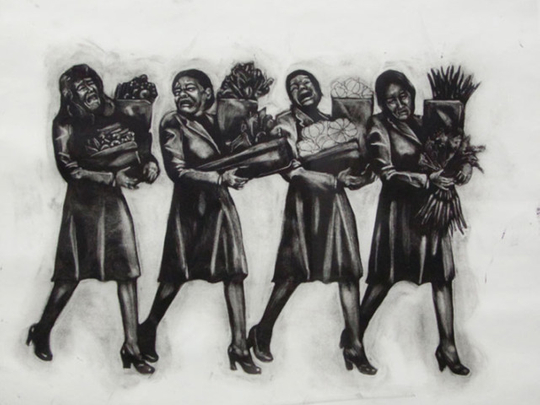
Amartey Golding’s latest exhibition, “Ga.Bo.Sia”, marks a turning point in his artistic career. The London-based artist, who is of Scottish and Ghanian descent, is known for his large charcoal drawings on unprimed canvas. But over the past year, he has been a resident artist at Tashkeel, where he has experimented with the new medium of dry point printing and developed a new artistic vocabulary based on the creation of a contemporary mythology.
Golding has used a mix of dry point printing and ink drawing to create the unique artworks in this show that marks the end of his stint as a guest artist. And he has woven his personal stories with contemporary culture and geopolitics, and a host of imaginary characters to formulate a mythology that transcends cultural and geographical borders. Like all mythological tales, Golding’s stories are about the struggle between good and evil and the power of love. And like all myths, the essence of his work is to provide a way for people to understand themselves and the world around them.
“This residency has been a period of self-examination for me, during which I have deconstructed and rebuilt my art practice. The issue of identity has been an important one for me because my mother is Scottish, my father was from Ghana, my stepfather was Jamaican, and I grew up in London as a mixed-race person. But in my new work I decided to deal with it in terms of the mythology that guides the way we see ourselves and the world. This work was inspired by Joseph Campbell’s book “The Hero With a Thousand Faces”, where he has explained that the mythologies of different countries and cultures are similar because they are essentially about our own psyche and inner struggles. As a mixed-race person, I have found it difficult to relate to Greek or any other mythology, so I decided I would forge a new mythology for myself that is not associated with any particular geographical area or culture. It is a mythology that everybody who is part of today’s growing multicultural community can relate to,” Golding says.
The artist’s mythical hero Mihael is based on his Jamaican stepfather, who was a major influence in his life; and the name of Gabos, his antagonist, is an acronym for “Game Ain’t Based on Sympathy”, a term used by American prisoners to describe their “every man for himself” credo of surviving in prison. The artist has also borrowed characters and ideas from Japanese, Chinese, Greek and African mythology. References to political leaders and pop-culture icons ranging from Obama, Hitler and Gandhi to Freud, Chaplin, Hemingway, Adele and Homer Simpson also appear in his etchings and drawings.
“My father died suddenly when I was 18. When I met my siblings from his other relationships at the funeral, I was amazed to find that the father I knew was so different from the person they knew. But now I understand that the stories we know affect our perception of reality. So there is this interesting parallel between the many myths of my father and the various myths I have created for this show. Although I never realised it, he has always been present in my work. But his overt presence here as a selfless hero is my tribute to him,” Golding says.
The artist’s mythology is filled with many interesting stories. There is the story of Gabos, the greedy, selfish, self-destructive guardian of a mythical utopia turned barren desert, who keeps all the food for himself and his children, while others are dying of hunger. And of Mihael and his friends, who sacrifice themselves so that their bodies can fertilise the barren land and save their families from starvation. There are headless giants, who destroy without thinking, comical Titans who clash as the world watches in distress, a two-headed horse that gets nowhere and good people who are doomed to die.
The artist underlines the parallels between this imaginary “Gabosian” world and the real world by mingling his mythical characters with media images of people and events — good and bad leaders; torture of prisoners in Guantanamo Bay; conditioning techniques of Shaolin monks; the Woolwich killer, whose misguided actions caused racial tensions in London recently; dead bodies of Palestinians and victims of IRA bombings; and a famous Pulitzer prize-winning picture of a starving baby in Africa.
Golding’s modern mythology is designed to reflect contemporary culture and attitudes, the personal and geopolitical conflicts we face today and our methods of resolving them. It makes us think about how the attitude and actions of our icons have affected our lives and our perceptions of good and evil. “Gabos symbolises the lack of sympathy and empathy that is so prevalent in our society today, and the imbalance this attitude has created in our world, making everybody a loser, while Mihael offers hope for a better future. By including faces, ideas and events from every part of the world, I am trying to write new mythologies that the new nomads of a globalised, interconnected generation can connect with and take guidance from,” Golding says.
Jyoti Kalsi is an arts enthusiast based in Dubai.
“Ga.Bo.Sia” will run at Tashkeel, Nad Al Sheba, until November 7.


